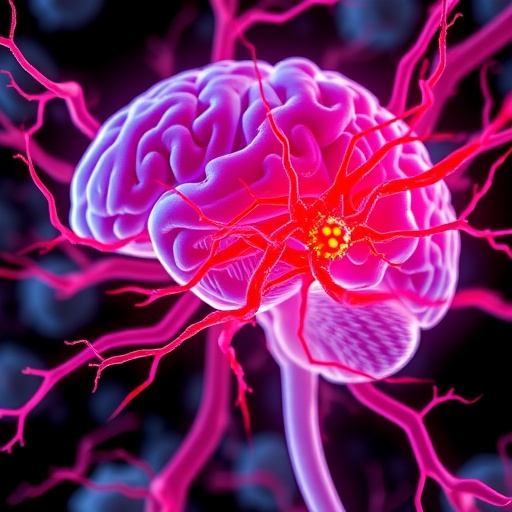
In the intricate landscape of infectious diseases, typhoid fever stands as a formidable global health challenge, primarily instigated by the bacterium Salmonella enterica serovar Typhi (S. Typhi). While typhoid fever is classically recognized for its febrile illness and systemic involvement, its neurological complications, particularly encephalopathy, have mystified clinicians and researchers for decades. Recent groundbreaking research has illuminated the insidious mechanisms through which the typhoid toxin, a unique virulence factor exclusive to S. Typhi, orchestrates neuropathology by compromising a critical neural defense—the blood–brain barrier (BBB).
The blood–brain barrier is a complex and highly selective interface that maintains central nervous system (CNS) homeostasis by regulating the passage of molecules between the bloodstream and brain parenchyma. Historically, the neurological manifestations of typhoid fever were attributed to direct bacterial invasion or systemic inflammatory responses. However, novel investigations have shifted this paradigm, highlighting a more nuanced pathway mediated by bacterial toxins that subtly but effectively dismantle the BBB’s integrity.
In pioneering experiments employing genetically engineered murine models, scientists have selectively shielded various tissue compartments from the deleterious effects of the typhoid toxin. These sophisticated models revealed a striking phenomenon: the toxin does not exert its neuropathological influence through direct injury to neurons or glial cells, as might have been assumed. Instead, its primary mode of action involves targeting the endothelial cells composing the BBB, thereby precipitating barrier dysfunction and enabling the influx of harmful substances into the brain’s delicate microenvironment.
Intensifying this understanding, in vitro models replicating the human BBB recapitulated the toxin’s disruptive impact. The diminished barrier integrity was quantifiable, with permeability assays demonstrating increased trans-endothelial leakage following exposure to typhoid toxin. Central to this effect is the CdtB catalytic subunit of typhoid toxin, an enzymatically active moiety responsible for inflicting DNA damage and perturbing cell cycle processes in BBB endothelial cells. This subunit’s activity critically undermines the structural and functional properties of tight junctions, molecular complexes that constitute the BBB’s shielding architecture.
The cerebral consequences of BBB breakdown are profound. Loss of selective permeability permits infiltration of inflammatory mediators, neurotoxins, and immune cells, fostering an environment conducive to neuroinflammation and neuronal dysfunction. Clinically, this cascade manifests as encephalopathy characterized by altered mental status, seizures, and, in severe cases, irreversible neurological damage—a grim reality that elevates the morbidity and mortality associated with typhoid fever beyond its systemic infection.
Remarkably, the translational potential of these insights extends to therapeutic strategies. Corticosteroids, widely known for their anti-inflammatory prowess and vascular stabilizing effects, emerge as promising agents to counteract typhoid toxin–induced BBB disruption. In vivo studies demonstrated that administration of corticosteroids significantly mitigated BBB permeability alterations, reinforcing their role as adjunctive therapy to forestall severe neurological complications in typhoid fever patients.
Beyond corticosteroids, these findings invite exploration into targeted molecular interventions aiming to neutralize the CdtB subunit’s enzymatic activity or bolster BBB resilience. Developing agents that preserve tight junction integrity or inhibit toxin internalization could revolutionize clinical management, transforming fatal complications into manageable sequelae.
This research elucidates a vital facet of S. Typhi’s pathogenic arsenal that had previously eluded definitive characterization. By unveiling the typhoid toxin’s subversive strategy to breach the CNS’s frontline defenses, science dissects a pivotal step in the progression from systemic infection to neural impairment. Such molecular clarity enables not only refined diagnostic biomarkers indicative of BBB compromise but also paves the way for precision medicine approaches tailored to the neurological dimensions of typhoid fever.
The study’s convergence of in vivo genetic models with cutting-edge in vitro systems exemplifies the power of integrated methodologies to unravel complex host-pathogen interactions at cellular and molecular scales. These models faithfully mimic human disease states, thereby enhancing the translational relevance of the findings for clinical application and public health policy.
In the broader context of infectious neurologic diseases, this revelation enriches the understanding of how bacterial toxins traverse and manipulate host barriers—a concept with implications transcending typhoid fever to other neuroinvasive pathogens. Lessons learned here may inform the pathogenesis of bacterial meningitis, neuroborreliosis, and other conditions where BBB integrity dictates disease outcome.
Furthermore, epidemiological surveillance must adapt in light of these mechanistic insights. Neurological assessment should be integral to typhoid fever management protocols, especially in endemic regions where health disparities impede early intervention. Early identification of BBB dysfunction could prompt timely administration of corticosteroids or inclusion in emerging therapeutic regimens, thereby curbing long-term neurological disability.
Education of clinicians regarding the pathophysiological underpinnings detailed in this research empowers better clinical judgment and multidisciplinary care coordination, ensuring that neurological symptoms in typhoid fever are promptly recognized and treated. Enhanced awareness could also stimulate patient advocacy and resource allocation for affected populations, fostering comprehensive disease management strategies.
Looking forward, multidisciplinary collaboration encompassing microbiology, neurology, immunology, and pharmacology is pivotal to further dissecting the nuanced interactions between typhoid toxin components and host BBB constituents. Advanced imaging modalities, single-cell transcriptomics, and proteomics hold promise for mapping the molecular crosstalk and identifying novel therapeutic targets.
In conclusion, the field now stands at a transformative juncture where the once obscure mechanisms of typhoid fever–associated encephalopathy are brought into sharp focus. Through meticulous experimentation and innovative modeling, the role of typhoid toxin-induced BBB disruption emerges as the linchpin of neuropathology. This discovery does not merely expand scientific knowledge but rejuvenates hope for effective interventions that can alleviate the devastating neurological impacts of a disease afflicting millions worldwide.
Subject of Research: Mechanisms of typhoid toxin in causing neuropathology through blood–brain barrier disruption in typhoid fever.
Article Title: Typhoid toxin causes neuropathology by disrupting the blood–brain barrier.
Article References:
Zhao, H., Catarino, J., Stack, G. et al. Typhoid toxin causes neuropathology by disrupting the blood–brain barrier. Nat Microbiol (2025). https://doi.org/10.1038/s41564-025-02000-z
Image Credits: AI Generated
Tags: bacterial virulence factorsblood-brain barrier disruptioncentral nervous system homeostasisencephalopathy in infectious diseasesinfectious disease research advancementsmechanisms of blood-brain barrier compromisemurine models in disease researchneurological impacts of typhoidSalmonella enterica serovar Typhisystemic inflammatory responses in typhoidtyphoid fever neurological complicationstyphoid toxin neuropathology





